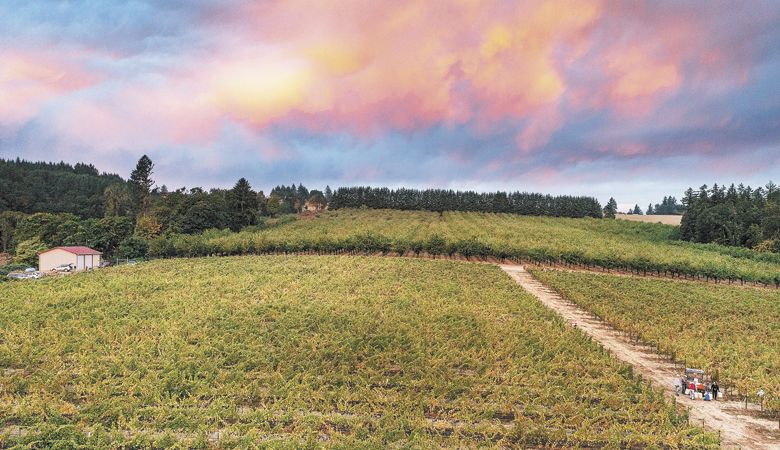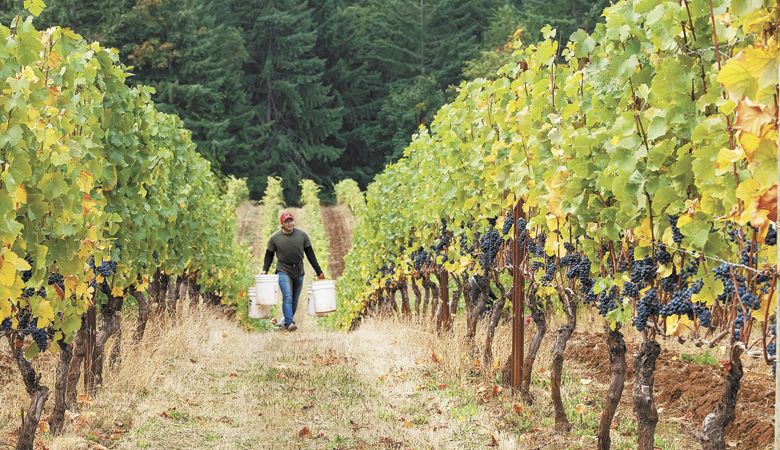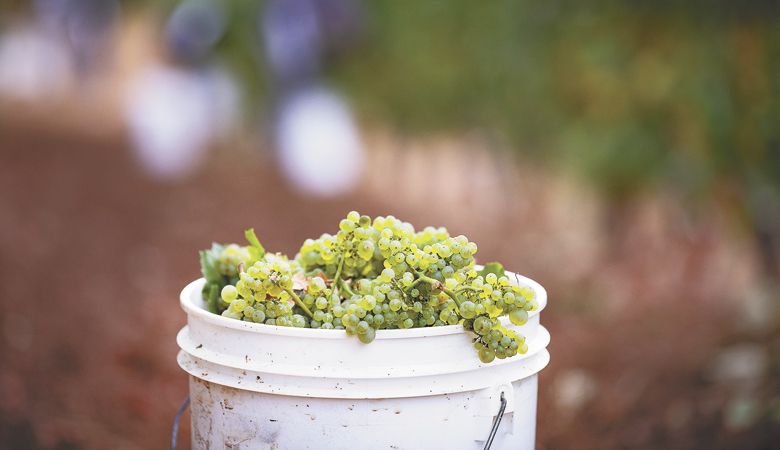Pick of the Crop
Great consistency across AVAs in 2021
With weather events diminishing fruit set and persistent smoke from a series of horrendous wildfires threatening to taint flavors, Mother Nature inflicted a lot of hurt across Western Oregon during the 2020 wine harvest. Total production was down from 25% to 50%.
Thankfully, last year was saved from failure because small clusters and berries in the surviving crop yielded deep color and concentrated flavors, resulting in high overall quality. By comparison, however, it wouldn’t have been a big stretch for 2021 to show improvement.
Although the vines got off to a somewhat lethargic start, over the course of this year’s growing season, they picked up a smooth, consistent pace and ultimately cruised across the finish line as, if not a record-setting, a close top-contending winner. In region after region around the state, early reports concur that 2021 will be a very good to great vintage.
In the northern Willamette Valley, Alex Sokol Blosser, co-owner/winemaker of half-century-old Sokol Blosser Winery in Dayton, notes a bit of rain at blossom time slightly reduced fruit set. Luckily, record-shattering 110-plus degree temperatures in June came right at a time when its potentially disastrous extreme heat conditions did the least possible damage to the vines.
The growing season was consistently warm, which was good, but also incredibly dry, which awakened a seldom seen insect that thrives when dust rises: spider mites. They can cause serious damage to vine leaves unless eradicated immediately. Spraying that potentially pesky pest aside, the next problem was labor, both in the vineyard and winery.
Given the struggles with COVID and other issues afflicting migrant vineyard workers, vineyards were plagued by undermanned picking crews throughout the harvest, many calling on the entire family. “Even 80-year-old dad was out there on a tractor,” Sokol Blosser says. Harvest began Sept. 21, a week early this year, and ended Oct. 7 for the winery. Complications surrounding passport approvals prevented South African interns from arriving, leaving them shorthanded in the winery, as well.
Despite these difficulties, Sokol Blosser could be counted among the vast majority of vineyards and wineries around the northern Willamette Valley witnessing balanced ripeness at harvest, no disease problems, impeccably clean fruit on the sorting line and concentrated juice in the fermenters. These circumstances all point to what should be an excellent vintage.
Christine Clair, winery director at Willamette Valley Vineyards, is an ideal representative to report on not one, but three Oregon regions where the company owns vineyards. The areas include: Tualatin Hills AVA, where the winery farms pioneering Tualatin Vineyards; the central Willamette Valley, where the estate vines and winery are located; and the Rocks District of Milton-Freewater AVA, part of the Walla Walla Valley. It must be noted the winery farms vineyards all around the Willamette Valley.
Tualatin Valley Vineyards, founded by Bill Fuller in 1973, sits in the Coast Range rain shadow just west of Forest Grove. This protected condition results in some of the state’s earliest ripening Pinot Noir, which Clair says was the winery’s first variety picked this year, along with some early-season fruit-set loss, resulting in average yields. Despite this, growing and harvesting presented no problems and high quality is anticipated.
The winery’s estate vineyard, just off I-5 at Turner, sits smack in the center of the Willamette Valley. Once again, average yields were harvested with low disease pressures and high fruit quality. Though powdery mildew has been previously experienced, this season’s low humidity alleviated that problem. Picking began two weeks earlier than normal and was completed mid-October.
“Everyone was excited by the fact that we had flawless fruit in our fermentations,” Clair says. “With a large winery crew [and] because of COVID, we took the precaution of putting groups on alternating shifts to minimize potential exposure.”
Willamette Valley Vineyards founder Jim Bernau’s great-great-great-grandfather, Paul Pambrun, was a Whitman Mission-era pioneer of the Walla Walla Valley. To honor him, he purchased vineyard acreage in SeVein, a high-demand, high-elevation Rocks District property, and founded Pambrun Winery in 2015. Clair says although a cool spring resulted in poor fruit set and low yields, the typically lengthy, warm, dry growing season has led to another high-quality vintage for 2021.
At Silvan Ridge Winery in Eugene, head winemaker JP Valot provided a succinct but detailed summation of the 2021 season in the southern Willamette Valley. Zero disease, fungus and pest issues. Harvest began two weeks earlier than average. Picked before the rains. Severe labor shortage problems. Very dry year. Nice, clean fruit. Good acid. Beautiful color. Concentrated. Very positive vintage picture.
Renowned wine climatologist Dr. Greg Jones took over management of his family’s Abacela Winery south of Roseburg shortly before this year’s harvest. With the many microclimates in the “100 Valleys of the Umpqua,” no single scenario will totally suffice, but the “Weather and Climate Summary and Forecast” he released Oct. 3 indicates average growing degree days in the Umpqua were within 5% of 2015, the hottest year on record.
Whether or not 2021 ultimately exceeds the current record will have to await complete calculations. But the possibility appears unlikely if his forecast of a cool fall leading into a wet December proves true.
Given the common characteristics of an exceptionally dry and a consistently warm summer across the Umpqua this season, Jones uses Abacela’s experience in saying, “The harvest was not rushed, the fruit came in clean, and quality looks very good overall. Picking will continue into November.”
Farther up the Umpqua come comments from Wade Smith, associate winemaker of Reustle-Prayer Rock Vineyards. He says that this was one of the earliest harvests ever, beginning the last few days of August with Pinot Noir and Pinot Gris, followed closely by the winery’s signature grape, Grüner Veltliner. Yields were close to normal and growing 15 different varieties gives them a broad range of perspectives on quality, which he feels, in some instances, may approach remarkable.
The cool climate of Elkton Oregon AVA, tucked away in the northwest corner of the Umpqua Valley, allows winemaker Terry Brandborg and his neighbors to grow and craft varieties similar to those in the northern Willamette Valley. At Brandborg Vineyard & Winery, they produce Pinot Noir, Pinot Gris, Chardonnay, Riesling and Gewürztraminer, all of which benefited from good set, good crop levels, very little disease pressure and an early harvest, brought about by a long, dry summer in 2021. In other words, excellent across the board.
Weisinger Family Winery can be found at the southern end of Bear Creek Valley where it meets the foothills of the Siskiyou Mountains. Bear Creek comprises the southernmost section of the expansive Rogue Valley AVA and is the warmest growing area in Oregon — at the foot of the foothills, that is. The winery is located there, where the elevation is 1,600 feet.
But that’s not the height at which Weisinger’s estate vineyards are planted. For that, general manager/winemaker Eric Weisinger says you must ascend at least another 300 feet. The vines are planted between the 1,900 and 2,200-foot levels, offering considerably cooler sites where varieties that no longer fare well in the AVA’s lower areas, still thrive.
How high can you grow? Weisinger says he had farmed an acre of Zinfandel at 3,100 feet in the Siskiyous, which is now doing better than ever as average annual temperatures and cumulative growing degree days continue to climb.
This year, yields were low, down 15% to 20%. But it wasn’t due to smoke problems, as might be assumed. “The fires in Northern California didn’t impact us that much,” Weisinger explains. “We got some smoke, but nothing that settled in. Having our irrigation supply cut off near the end of the season reduced our yields.” As far as timing, “It’s the first year that we’ll be finished up by Halloween in a very long time,” he says.
Mike Wisnovsky, with brothers Mark and Bob, has been playing a part in the management of Valley View Winery since 1980, when he was just a child. He knows their 35 estate acres like the back of his hand. “Our yields were slightly below average in 2021, but we got great color and good ripeness in a very hot year,” he says. “Unlike the Rogue, water is no problem for the Applegate AVA because of our flood protection reservoir. We installed overhead sprinklers for frost control in addition to the drip irrigation. That kept things well in check.”
Like almost everyone else, however, worker shortfalls presented a problem. Still, it only took them a month to bring in all the fruit. “We started early, on Sept. 21, and finished early, on Oct. 22.” Wisnovsky notes. “We’re celebrating our 50th anniversary this year, so having a good season is a very good sign.”
Several miles west of the Applegate lies the Illinois Valley. Considerably closer to the ocean, it boasts commensurately cooler growing conditions. Pinot Noir continues to be a featured player. Ted Gerber founded Foris Vineyards there in 1986, back when the remote area’s main attraction was, and still is, The Oregon Caves.
We don’t have nearly the water problems here,” Gerber says. “We mostly dry farm. And we pretty much escaped this year’s record heat.” He built OSHA-approved farm labor housing, which attracted workers who picked almost all of Foris’ 181 acres, which showed no vine issues and produced fruit as clean as a whistle. “We tried out mechanical harvesting this year on 12 acres,” he says. “It was a learning experience.” All things considered, Gerber deemed 2021 “an extremely good vintage.”
Bob Morus, only a year and half away from celebrating the 30th anniversary of his Phelps Creek Vineyards in the Columbia Gorge, officially retired in 2020 from a 34-year career as a pilot for Delta Airlines. He pursued both flying and winegrowing simultaneously and with equal passion for almost three decades. “COVID convinced me to hang up my wings,” he says. “Now, I’m hanging out here in the gorgeous Gorge experiencing my second vintage since retiring. And I can’t tell you how glad I am the second wasn’t like the first.”
With 2020 in the rearview mirror and the unaffected wines that emerged from last year’s difficult vintage looking exceptionally good, Morus has placed his primary focus on this year, 2021, with its upward trajectory not only for his winery but for all the area wineries up and down the 40-mile expanse of the Columbia Gorge AVA.
No major negatives from the extreme heat. Great fall weather. Consistent, slow ripening. Shortage of labor posed a problem, but they got through it. The harvest window was short: the first through the last week of September. The final verdict? In his own words, Phelps Creek’s owner declared the outcome of this season’s harvest to be “emphatically beautiful.”













